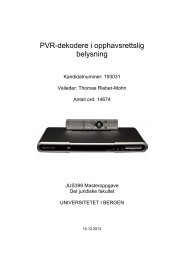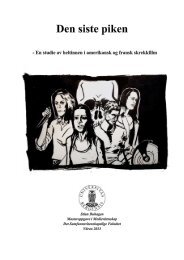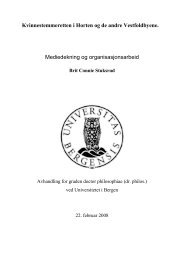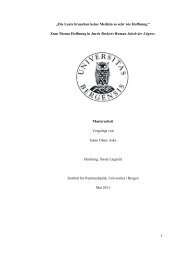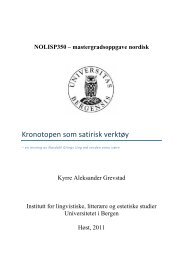View/Open - BORA - Universitetet i Bergen
View/Open - BORA - Universitetet i Bergen
View/Open - BORA - Universitetet i Bergen
You also want an ePaper? Increase the reach of your titles
YUMPU automatically turns print PDFs into web optimized ePapers that Google loves.
Summary<br />
Drinking culture in an urban context in <strong>Bergen</strong> in late medieval and early modern times<br />
The aim of this thesis was to address questions related to drinking culture in an urban context<br />
in late medieval and early modern times, based on an analysis of the archaeological finds<br />
recovered from Room 1 in the medieval Wine Cellar (Vinkjelleren) in <strong>Bergen</strong>. From the<br />
Wine Cellar, that was a part of the Town Hall, the City Council had royal monopoly on the<br />
wine sale in <strong>Bergen</strong>, from which they also received profits. The Wine Cellar was in use from<br />
around 1300 until it was torn down in 1651. From 1437, or somewhat earlier, it was leased by<br />
the German Office of the Hanseatic League.<br />
My main focus has been on the pottery, which amount to 2117 finds. These have been<br />
identified and classified based on provenience and fabric characteristics, such as hardness,<br />
colour and decor. My classification shows a large degree of homogeneity in the material, with<br />
German Siegburg stoneware constituting 85 percent of the recorded sherds. This probably<br />
reflects the increasing cultural, economic and political influence from German traders, who<br />
were present in large numbers at the German Office at Bryggen.<br />
The Siegburg stoneware was chosen for further analysis. Compared to the production<br />
site, the type variation turned out to be limited, a possible sign of difference in use. The<br />
Siegburg material also showed few distinctive characteristics, like decor, indicating a lack of<br />
social distinctions in the cups themselves. There is, however, a distinction between the pottery<br />
and the glass material in the Wine Cellar, as the distribution of glass is confined to only one<br />
part of the room. This indicates that the room could have been divided into different zones<br />
and this could perhaps be related to social differentiation.<br />
Furthermore, my analysis determined the relation between the types related to drinking<br />
and the types related to serving respectively, and how these are distributed in time and space.<br />
Drinking vessels dominated throughout the whole period, and their presence increased over<br />
time: from 54 % in the earliest period to 71 percent in the latest. The great number of drinking<br />
vessels, opposed to fewer serving vessels, indicates an increase in the use of individual<br />
drinking vessels as opposed to communal ones, and can be related to an overall trend, where<br />
the society during this period were moving towards a larger degree of individualization.<br />
89





